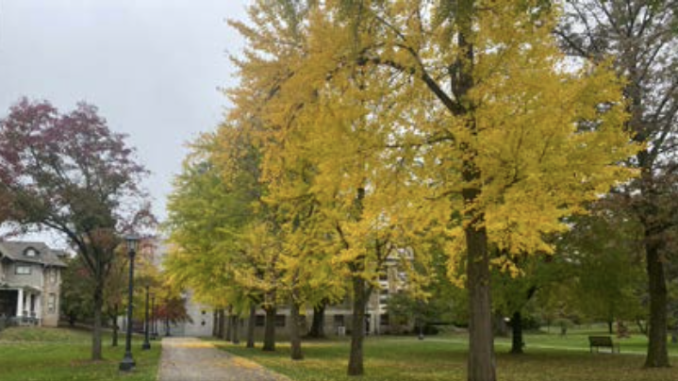
Chase Portaro (chportaro@ursinus.edu)
The Ginkgo Biloba, steeped in Chinese as well as Philadelphian history, is considered to be one of the oldest species of tree on Earth, but for students at Ursinus College, it may be the stinkiest tree on Earth as well.
The ten Ginkgo trees located along the walkway between Pfalher hall and Main Street have been especially bothersome for Main Street Residents, who contend with their stench on their daily walks to class. When Matthew Nieves-Hoblin ‘23 lived in Omwake last year, which is right in front of Pfhaler, he said, “It smelled like vomit every morning when I would walk outside.”
Steve Gehringer, Director of Facilities at Ursinus, said, “The nut does have a particular smell, especially if it is crushed.” The Ginkgo nut, according to GardeningKnowHow.com is “a fleshy, brownish orange about the size of a cherry.” Gehringer also explained that in its raw form, the nut “is considered poisonous since it causes a deficiency disorder of [Vitamin] B6 within a few hours” after ingestion– as if the putrid stench of the Ginkgo nut wasn’t enough reason for avoidance.
The trees’ aesthetic value, however, allows some students to tolerate their nasal protests. Story Coleman ‘24 said, “For the rest of the year, I love them, they’re beautiful trees. They add a really nice ambience to the campus– it’s just these few weeks when they smell awful.”
Those few weeks when Ginkgos drop their rancid-smelling fruit, or scientifically termed rancid-smelling “nuts,” have to do with the tree’s evolutionary history. Considered a “living fossil” by scientists due to its 270 million year existence, the Ginkgo nuts’ rotten smell helped attract animals that would eat the flesh-like nut and spread the Ginkgo species to new places. The tree is so old and has evolved so little since then, it’s possible that a dinosaur could have eaten a Ginkgo nut just like the ones stinking up the grounds of Ursinus.
Modern-day science explains Ginkgos as dioecious trees, which means that Ginkgos are either solely male or female. Gehringer said, “The female trees drop fruit– the male trees do not drop fruit. My guess is whoever planted them [at Ursinus] did not know they were female trees.”
The question of how they got to Ursinus, though, is shrouded in mystery. Emily Gurganus ‘24 told me, “The common mythos is that POD [Pi Omega Delta] planted the trees years ago.” It’d make sense that the fraternity that calls themselves the “Pieces of Dirt” would be responsible for the tree planting, but that mythos is unproven.
The long and winding road that connects the East Asian Ginkgo to the streets of Philadelphia, however, has been proven. Traditionally farmed by Chinese Monasteries in the 11th century, the Ginkgo was rediscovered by Europeans in 1691. Global imperialism brought the Ginkgo to Europe in the early 1700’s. Then, in 1784, the very first Ginkgo in North America arrived in Philadelphia at The William Hamilton Woodland’s Estate. The Estate was gifted three Ginkgo trees, but it donated one tree to historic botanist William Bartram. Bartram’s tree was the only one of the original three to survive, and you can still visit the continent’s very first Ginkgo at Bartram’s Garden in SW Philadelphia.
Since the Ginkgo’s arrival in 1784, its Philadelphian history has been “rooted” in its place of origin – China. Chinese immigrants in the city have traditionally gathered fallen Ginkgo nuts for their medical benefits. Although poisonous in its raw form, Gehringer said, “If carefully harvested, the Ginkgo yields a nut meat that’s edible in small amounts. The Chinese believe that Ginkgo nuts have medicinal and aphrodisiac properties, and use them in congees, and certain dishes served on special occasions.”
According to the Philadelphia Inquirer, although the foraging tradition “has waned among Asian Americans, it has risen elsewhere.” While you might see pedestrians along Spruce St. in Center City or parts of South Broad St. in South Philly gathering up fallen Ginkgo nuts, you might have a hard time convincing Ursinus students to pick up a nut next time they come across one.
Mitigating the stink of the Ginkgo is a high priority for facilities, as Gehringer said, “The grounds staff blow the fruit off the Main walkway onto the grass area every other day.” But other than temporary displacement, there isn’t much else the Grounds Staff can do to eliminate the smell. The Ginkgo may stink terribly, and it may not even be native to Pennsylvania. But as a tree that survived the atomic bomb in Hiroshima and can live for more than 1,000 years, the Ginkgo is here to stay in Collegeville for the time being.
